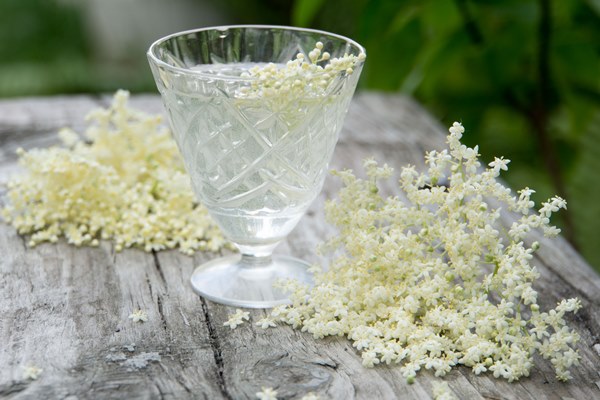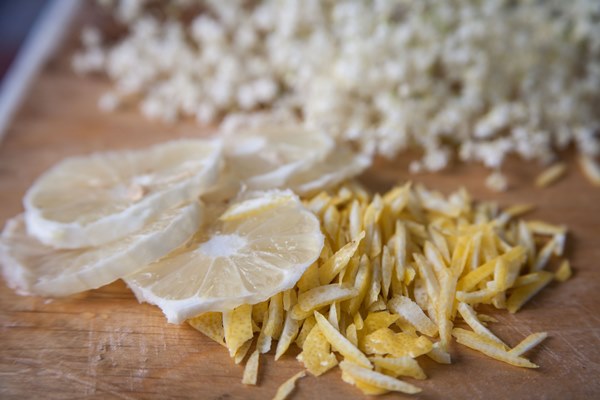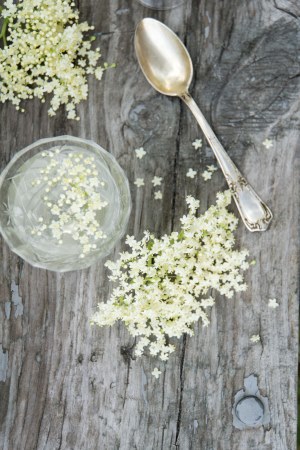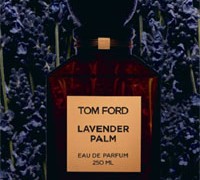Sugar to flavors is like amber to butterflies. It captures even the most delicate of nuances of flowers like roses, violets or acacia. I don’t have a particularly strong sweet tooth, and yet you can tell by the number of articles I’ve written about making candied flowers and searching for Persian sugared jasmine or Provencal glazed mimosa, how much this topic fascinates me. Now that the elderflowers are in bloom, I want to capture the effervescent ballet of their aromas in something. A candy. A jam. Or perhaps, a cordial.

Elderflower cordial is a popular drink in Belgium, where it’s sold diluted as a soft drink, but growing up in Ukraine, I’ve never associated elderblossoms with anything but tisane. My great-grandmother occasionally used the berries to make cough syrups, but I don’t remember them tasting appealing. I liked their intense violet color and once tried to use them as fountain pen ink. That didn’t go over well. The aroma of elderblossoms in early summer, however, was one of my vivid childhood memories.
Elderflowers smell bittersweet, with a strange musty-spicy note that at first can seem unpleasant. Yet, inhale deeper, and you notice hints of hay, sweet acacia and honey. Wait a little longer and take another inhale, and you can smell the green sap of spring buds and lemon peel.

The elusive lemony accent is the reason that elderblossoms find a perfect match with citrus, especially lemon. The acidity is an important element in a cordial, and in the recipe below, it’s reinforced by citric acid. The aroma of lemon peel, however, is a key note. It makes the flowers shimmer.
The cordial is simple to make. You infuse flowers in heavy sugar syrup and let time do its magic.


To make a drink, mix 1 part of syrup to 3 parts of water (or to taste) and stir well. Mint leaves bring out the green nuances of elderflowers, while crushed strawberries or peaches enhance the warm fruit nuances. You can also mix it with champagne or sparkling wine.
Once you have the cordial, you can also use it to flavor cakes, custards, crepes and even tomato salads. Use it instead of honey in any savory recipe and discover that this dainty blossom has a bold flavor.

Elderflower Cordial
I found this recipe in the June 2010 issue of Good Food magazine and adapted it by increasing the proportion of flowers. You can use the same method to make rose or violet cordial.
5.5 lb (2½ kg) white granulated sugar
1.5 litres (6.5 cups) water
2 lemons, preferably organic
40 fresh elderflower heads, stalks trimmed
1/2 cup + 2 Tablespoons (85g) citric acid
Heat the sugar and water in a large pan on low heat, stirring time to time until all of the sugar is dissolved. Bring to a boil and remove from the heat.
Peel lemons with a zester to remove the colored yellow part of the skin. Chop it and set aside. Trim off as much of the bitter white pith as possible from the lemon and discard it. Slice the lemons into rounds.
I don’t wash the elderflowers, since the syrup is going to be filtered anyway, but you can put the whole lot into a colander and run cold water over it.
Mix citric acid into the syrup and add the rest of the ingredients–the lemon zest, the lemon slices, and the elderflowers. Cover and set aside for 24h for the aromas to meld.
After 24h, filter the syrup through a fine cheesecloth, without pressing onto the solids. Store it in sterilized bottles in a cool place.
To make a drink, mix 1 part of syrup to 3 parts of water (or to taste) and stir well.
Recipe from Good Food magazine, June 2010.
Photography by Bois de Jasmin
















50 Comments
Annie: I’ve seen these flowers, but I didn’t know that they were edible. June 7, 2019 at 8:26am
Victoria: They are indeed! And they’re very pretty too. June 9, 2019 at 10:30am
rosarita: I’ve read about elderberry cordial so I’m happy to have the recipe, thanks! I grew up in the US Midwest, in Amish country, where pies are prized. Elderberry was one of my father’s favorites and I remember picking and cleaning the berries every year. June 7, 2019 at 8:45am
Victoria: I’m now curious to try an elderberry pie. I wonder how they are made, since elderberries have so many seeds. June 9, 2019 at 10:30am
rosarita: You eat the seeds too, the way they scrunch in your teeth is part of the appeal 🙂 June 9, 2019 at 2:37pm
Victoria: I’ll have to see if I can find any berries here. June 11, 2019 at 11:11am
Heidi: Oddly enough, you can buy elderflower cordial at IKEA, though I’m sure it lacks the nuances of your recipe! June 7, 2019 at 9:16am
Victoria: Yes, it’s a common syrup in the Scandinavian countries as well. June 9, 2019 at 10:31am
Gabriela: Elderberry syrup is the best remedy for coughs and colds, you’re great grandmother knew well. I had no idea you could use the flowers, very interesting! June 7, 2019 at 9:21am
Victoria: She had many such potions. 🙂 June 9, 2019 at 10:31am
Marsi: Have you ever seen any perfumes with an elderflower note, Victoria? It seems like the scent may be too delicate to show up amidst other notes, but it would be interesting to know if anyone has tried. June 7, 2019 at 9:26am
Victoria: I haven’t. I was thinking about something similar, but really, it’s too subtle of a floral note. June 9, 2019 at 10:31am
Martha: I don’t think I’ve ever seen elderflowers, and they don’t, to my knowledge, grow in Houston, but I do have unsprayed, fragrant antique roses in my garden. If I were to make rose cordial, how many roses would be equivalent to 40 elderflower heads? June 7, 2019 at 10:39am
Victoria: 20-25 roses would be plenty. June 9, 2019 at 10:32am
Martha: Thanks! June 9, 2019 at 2:11pm
Tami: I’m always surprised how much I enjoy elderflower, as I don’t generally enjoy floral flavors (e.g. violet candy, sugared rose petals, etc.). Admittedly, I’m primarily familiar with it in St. Germain, which has a beautiful flavor in its own, and it pairs gorgeously with champagne or gin. Last year I made an elderflower and lemon cake, “inspired” by the royal wedding cake. I used St. Germain in the cake as well as the frosting. It made for a lovely treat, with an “elevated citrus” flavor. I do want to use it again, maybe in a tea cake or shortbread. June 7, 2019 at 10:44am
Victoria: I also didn’t expect to like it as much as I did. Now, I want to try that cake recipe too. June 9, 2019 at 10:32am
Tami: I started with this recipe from the BBC, and made some tweaks (for example, caster sugar is hard to find and tends to be pricy in the US, so I substituted superfine sugar; also, I added a little liqueur to the frosting as well). It would be lovely for a summer party or picnic!
https://www.bbcgoodfood.com/recipes/elderflower-lemon-celebration-cake June 9, 2019 at 12:31pm
Victoria: Thank you very much! June 11, 2019 at 11:10am
Suzana: I am sipping a fermented elderflower drink as I write. It’s made from elderflowers that I foraged in a park nearby, lemon and honey. My grandfather in Romania used to make small barrels of this drink (it’s called ‘socată’) and let it ferment until it was sparkly and slightly heady from the alcohol content. Elderflowers have always fascinated me – the delicate white dentelle contrasting with the strong intoxicating smell. June 7, 2019 at 4:30pm
Victoria: That sounds wonderful! And I loved learning about socată and the way your grandfather made it. Thank you for sharing about Romanian customs here. June 9, 2019 at 10:34am
Lindsay Woodman: I made elderflower cordial last year and on a whim threw in some damascena rose petals. Wow! Good decision. A lush silky delicate pink cordial. Lifted the spirits like nothing else. Also Elder is traditionally a fairy tree so elderflower cordial is a little drop of magic. June 7, 2019 at 5:30pm
Victoria: A decision that a perfumer would make. 🙂 June 9, 2019 at 10:34am
Lindsay Woodman: How did you know! June 9, 2019 at 1:07pm
Victoria: Just a guess. June 11, 2019 at 11:10am
MaureenC: It’s very popular in the UK too good cordial is available in most supermarkets and a lot of people make their own. Elderberry cordial is also packed with vitamin c and can taste good diluted with hot water in the winter. Much harder to make though as the berries are very fiddly to handle. It needs lots of sugar to be palatable. I suspect your granny’s recipe was low in sugar as a medicine rather than a drink for pleasure! June 8, 2019 at 2:12am
MaureenC: I should have said it’s the Elderflower cordial that is very popular and available everywhere! June 8, 2019 at 2:14am
Victoria: Yes, I don’t remember it being particularly sweet. 🙂 June 9, 2019 at 10:43am
Aurora: Thank you Victoria for a refreshing recipe. Here in the UK elderflower cordial is traditionally popular and the ready-made Belvoir cordial is really delicious. June 8, 2019 at 5:12am
Victoria: I also once tried an elderflower jam, which was delicious. June 9, 2019 at 10:44am
elvie elvanui: Mmmm… I have grown up with elderflower cordial. Here in Hungary every granny makes them in June:). My MIL has tried a new recipe, one with caramellized sugar, a few years back, but she also makes the traditional one and both are gorgeous. It tastes like childhood. My kids drink it by the gallon:). It is positively the tastiest drink after apple cider in my opinion;).
I have always wanted a perfume that gives me this fascinating, ethereal, honeyed-polleny-citrus scent, but alas, haven’t found one yet. Does anyone have any suggestions?
Thank you for the article!!! June 8, 2019 at 6:35am
Victoria: I also haven’t. Penhaligon’s Ostara doesn’t smell like elderblossoms, but it has that pollen-citrusy scent you’re talking about. The only problem is that it’s discontinued and can be hard to find.
I’ll continue looking. June 9, 2019 at 10:45am
Karen A: Oooh, inspiring! I’ve been scouting out the elderberry shrubs while they are blooming, waiting to make jelly with the berries but now I’ll go collect some flowers! June 8, 2019 at 4:40pm
Victoria: Definitely recommended! Also, another great match is gooseberries and elderflowers, in compotes or jams. June 9, 2019 at 10:46am
Fleurycat: What a lovely reminder as we look forward to evenings outside with a cool drink! My daughter and I had a lovely cocktail, really a white wine spritzer, a few summers ago in Berlin in which Elderberry Syrup was the star player. The Hugo is made with bruised fresh mint leaves, fresh squeezed lime juice, Elderberry syrup, Prosecco, and sparkling water. There are quite a few variations, and the French liqueur St. Germaine can be used to make a similar cocktail. The flavor of the Elderberry syrup is just so incredibly delicate and unique. It is now a staple in our house. June 8, 2019 at 7:21pm
Victoria: St. Germaine is a nice touch, and it’s quite complex. June 9, 2019 at 10:21am
Fleurycat: I mostly drink wine, but I especially love the Elderberry syrup I purchased in Germany and the St. Germaine in summer drinks. June 10, 2019 at 1:52pm
Fleurycat: I once made a homemade liqueur with Magnolia blossoms which was not particularly memorable! If Elderflowers are available here in North America am not aware of it. Therefore I try to purchase Elderberry syrup when I sm able to travel in Europe. Your photos are the first I’ve seen of the blossoms, and they are also so delicate and beautiful! June 8, 2019 at 7:34pm
Victoria: I’ve had a delicious mangolia wine in France, and I’ve tried making it myself. But I suppose that it depends on the aroma of the flowers you have. June 9, 2019 at 10:21am
Fleurycat: The Magnolia blossoms I used (Magnolia japonica “Anne” had a lovely lemony fragrance, part of reason I chose this particular tree, however the recipe, my first such venture, called for lemon peel and other ingredients which overwhelmed the delicacy of the Magnolia. I do have an unusual Magnolia tree at the back of our property, with stunning blossoms, but a surprisingly unpleasant smell. June 10, 2019 at 1:48pm
Victoria: Yes, I can see why lemon peel would be too much. Mangolia already has a citrusy accent. June 11, 2019 at 11:07am
Chris in Oakland: As someone mentioned above, elderflower cordial can be bought very inexpensively at Ikea, even in the US! 🙂 June 13, 2019 at 11:30pm
Fleurycat: Fleurycat, again. My error. I have a type of Elderflower prominently featured in my own garden: Sambucus Nigra “Black Lace”, so I suspect the Sambucus used as an edible is easily grown here, but just isn’t utilized. I will have to do a bit of research! Maybe I can make my own cordial or syrup 😊 June 8, 2019 at 8:47pm
Victoria: I’ve seen this tree a lot in the US, so I suspect that it’s not as used there as much it is in Europe. If you have only a couple of bunches of flowers, you can add them to a strawberry compote. The flavor will be so vivid. June 9, 2019 at 10:19am
Fleurycat: Yes, I suspect culinary use it is not part of the culture, our loss, but there are blossoms on my plant now, so I may try your suggestion. I’m not sure these particular blossoms will have the same flavor (they are pink, and the leaves are deep burgundy), since the plant is a hybrid grown primarily for ornamental use, but I now know that Elderberry plants grow easily here in the States. June 10, 2019 at 1:29pm
Victoria: It doesn’t seem like the same thing. Does it have a strong scent? June 11, 2019 at 11:07am
Fleurycat: I wouldn’t want to mistakenly use or to suggest anyone else use something harmful or toxic! Indeed, American Elderberry (Sambucus canadensis) is fine, but not Red Elderberry (Sambucus racemosa), which is unfit for consumption and whose berries are toxic. The flowers and fully ripened berries of the American Elderberry are edible (its other parts are indeed poisonous). While the flowers are edible, it seems the stems are not. I would never use a plant for consumption until making sure it is safe. I do not know if the hybrids are edible
and safe, but would do more research before pursuing. June 11, 2019 at 11:32am
Victoria: Thank you, this is very good to know. I need to look up this particular variety. June 12, 2019 at 5:57am
Nina: We drink it a lot in Sweden, especially in the south where the lemonade is called Hyllesaft.
I do it slightly different: I don’t peel the lemons, just slice them and throw them in a bucket with the flowers, then pour the hot water+sugar over and cover with cloth. I always steep them for at least 3 days, sometimes 5, to get a really intense flavour. This is really delicious, especially as a summer drink with a little vodka;) June 9, 2019 at 8:31am
Victoria: I keep the yellow zest, but I trim off the white pith, which can be very bitter and can ruin the delicate flavor of elderflowers. If I have sweet lemons, then I proceed the same way you do. June 9, 2019 at 10:18am